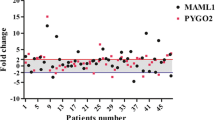Abstract
Notch signaling is an important cellular pathway which affects the development and function of many organs. It plays critical roles in maintaining of progenitor stem cell population as well as balancing cell proliferation, survival, differentiation and apoptosis. It has been shown that notch signaling is aberrantly activated during the carcinogenesis of a variety of human cancers. In this study we aimed to explore activation of this signaling pathway in esophageal squamous cell carcinoma (ESCC) through expressional analysis of notch signaling target genes. The mRNA expression of HEY1and HEY2 was comparatively analyzed by real-time PCR in tumor and related margin normal tissues of 50 ESCC patients. Comparative quantitative real-time PCR indicates the overexpression of HEY1 and HEY2 in 54 and 30 % of ESCC samples, respectively. Overexpression of HEY1 was significantly associated with stage of the tumor (p = 0.048) and tumor location (p = 0.008). HEY2 overexpression was also significantly correlated to node metastasis of tumor cells (p = 0.043). Overexpression of HEY1 and HEY2 in ESCC is correlated to different indices of poor prognosis and it is extrapolated that such overexpression is important in progression and development of ESCC tumorigenesis. To the best of our knowledge, this is the first report introducing aberrant activation of notch signaling target genes in ESCC, where it plays roles in development and progression of the malignancy and may be considered in therapeutic modalities to restrict ESCC progression.

Similar content being viewed by others
References
Wang Z, Li Y, Banerjee S et al (2009) Emerging role of notch in stem cells and cancer. Cancer Lett 279(1):8–12
Chiba S (2006) Notch signaling in stem cell systems. Stem Cells 24(11):2437–2447
Leong KG, Karsan A (2006) Recent insights into the role of Notch signaling in tumorigenesis. Blood 107(6):2223–2233
Carlson ME, Conboy IM (2007) Regulating the Notch pathway in embryonic, adult and old stem cells. Curr Opin Pharmacol 7(3):303–309
Radtke F, Clevers H, Riccio O (2006) From gut homeostasis to cancer. Curr Mol Med 6(3):275–289
Katoh M (2002) WNT and FGF gene clusters (review). Int J Oncol 21(6):1269–1273
Katoh M, Katoh M (2007) Notch signaling in gastrointestinal tract (review). Int J Oncol 30(1):247–251
Artavanis-Tsakonas S, Rand MD, Lake RJ (1999) Notch signaling: cell fate control and signal integration in development. Science 284(5415):770–776
Scoville DH, Sato T, He XC et al (2008) Current view: intestinal stem cells and signaling. Gastroenterology 134(3):849–864
Wilson A, Radtke F (2006) Multiple functions of Notch signaling in self-renewing organs and cancer. FEBS Lett 580(12):2860–2868
Adepoju O, Wong A, Kitajewski A et al (2011) Expression of HES and HEY genes in infantile hemangiomas. Vasc Cell 3:19
Katoh M, Katoh M (2007) Integrative genomic analyses on HES/HEY family: Notch-independent HES1, HES3 transcription in undifferentiated ES cells, and Notch-dependent HES1, HES5, HEY1, HEY2, HEYL transcription in fetal tissues, adult tissues, or cancer. Int J Oncol 31(2):461–466
Kageyama R, Ohtsuka T, Kobayashi T (2007) The Hes gene family: repressors and oscillators that orchestrate embryogenesis. Development 134(7):1243–1251
Forghanifard MM, Moaven O, Farshchian M et al (2012) Expression analysis elucidates the roles of MAML1 and Twist1 in esophageal squamous cell carcinoma aggressiveness and metastasis. Ann Surg Oncol 19(3):743–749
Sobin LH, Fleming ID (1997) TNM classification of malignant tumors, fifth edition (1997). union internationale contre le cancer and the american joint committee on cancer. Cancer 80(9):1803–1804
Moghbeli M, Abbaszadegan MR, Farshchian M et al (2013) Association of PYGO2 and EGFR in esophageal squamous cell carcinoma. Med Oncol 30(2):516
Forghanifard MM, Moghbeli M, Raeisossadati R et al (2013) Role of SALL4 in the progression and metastasis of colorectal cancer. J Biomed Sci 20:6
Liu J, Sato C, Cerletti M et al (2010) Notch signaling in the regulation of stem cell self-renewal and differentiation. Curr Top Dev Biol 92:367–409
Koch U, Radtke F (2007) Notch and cancer: a double-edged sword. Cell Mol Life Sci 64(21):2746–2762
Stylianou S, Clarke RB, Brennan K (2006) Aberrant activation of notch signaling in human breast cancer. Cancer Res 66(3):1517–1525
Ohashi S, Natsuizaka M, Yashiro-Ohtani Y et al (2010) NOTCH1 and NOTCH3 coordinate esophageal squamous differentiation through a CSL-dependent transcriptional network. Gastroenterology 139(6):2113–2123
Gaetani P, Hulleman E, Levi D et al (2010) Expression of the transcription factor HEY1 in glioblastoma: a preliminary clinical study. Tumori 96(1):97–102
Acknowledgments
The authors gratefully acknowledge the colleagues at Division of Human Genetics and Departments of Surgery and Pathology at Omid Hospital in Mashhad University of Medical Sciences for their technical assistances. This study was supported by a grant from the Vice Chancellor for Research at Mashhad University of Medical Sciences (#900861).
Author information
Authors and Affiliations
Corresponding author
Additional information
Mohammad Mahdi Forghanifard and Shaghayegh Taleb are contributed equally.
Rights and permissions
About this article
Cite this article
Forghanifard, M.M., Taleb, S. & Abbaszadegan, M.R. Notch Signaling Target Genes are Directly Correlated to Esophageal Squamous Cell Carcinoma Tumorigenesis. Pathol. Oncol. Res. 21, 463–467 (2015). https://doi.org/10.1007/s12253-014-9849-8
Received:
Accepted:
Published:
Issue Date:
DOI: https://doi.org/10.1007/s12253-014-9849-8




